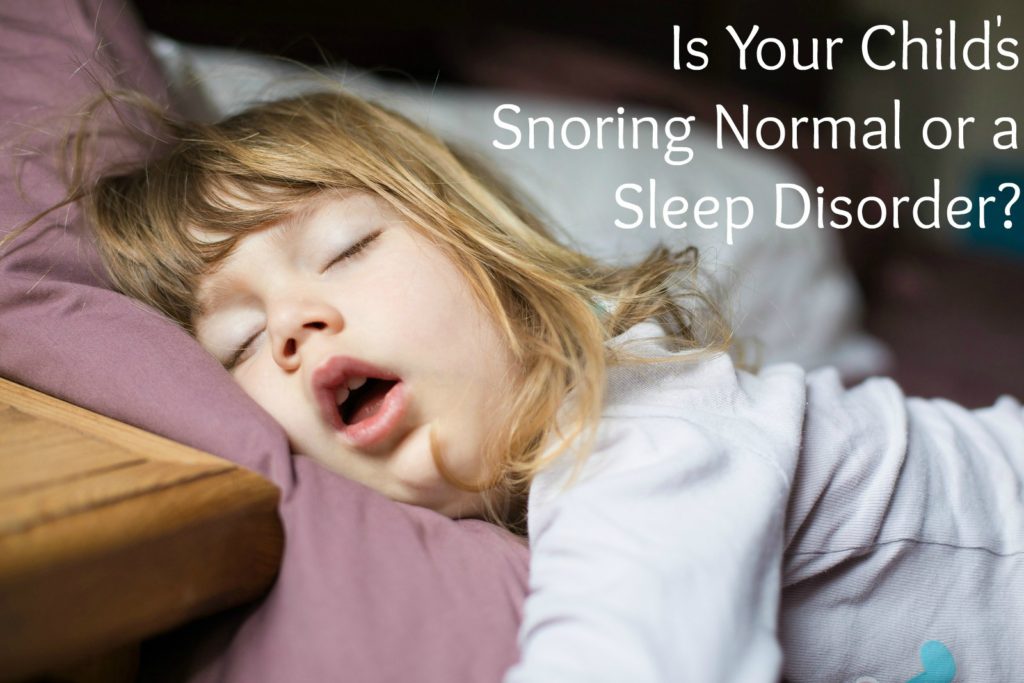Snoring is the sound that occurs during sleep when a person breathes in and there is some sort of blockage of air passing through the back of the mouth. When the air passage opens and closes it causes a vibration of the tissues in the throat resulting in snoring. How loud the snore is depends on how much air passes through and how fast the tissue is vibrating. Everyone snores to some extent, but when is it a cause for concern for your child?

According to the National Sleep Foundation, many, if not most, children snore on occasion, with around 10 to 12 percent snoring most nights. Snoring that is not associated with serious problems like obstructive sleep apnea (OSA) is known as primary snoring and is considered normal. Loud and regular nightly snoring is abnormal for a healthy child. If the loud snoring is due to an allergy, a stuffy nose or a respiratory infection, it will pass as soon as the illness does. If it continues, it may be a symptom of OSA.
Around one to three percent of children not only snore but also suffer from breathing problems during their sleep. If your child is snoring at least three nights a week and is associated with any of the following signs or symptoms, they may have OSA:
Nighttime symptoms-
- Snores loudly and regularly
- Pauses, gasps, and snorts and stops breathing momentarily. The snorts or gasps may waken them and disrupt their sleep.
- Be restless or sleep in abnormal positions with their head in unusual positions
- Sweating heavily during sleep
- Bedwetting
Daytime symptoms-
- Have behavioral, school and social problems- such as ADD or ADHD
- Difficult to wake up
- Have headaches during the day, but especially in the morning
- They are irritable, agitated, aggressive, and cranky
- They are so sleepy during the day that they fall asleep or daydream
- Speak with a nasal voice and breathe regularly through the mouth
OSA may also be coupled with delayed growth and cardiovascular problems. The most common physical problem associated with OSA in children is large tonsils. Their tonsils are rather large in comparison to the throat, peaking at five to seven years of age. Enlarged tonsils can block the airway, making it difficult to breathe and could suggest OSA. Each year, more than 263,000 children in the U.S. have tonsillectomies and sleep apnea is a major cause, according to the National Center for Health Statistics. The risk of OSA also increases in overweight and obese children as fat may form around the throat constricting it, and too much fat in the stomach can prevent the diaphragm from functioning properly.
What can you do if your child snores?
The best thing you can do is monitor your child’s nightly – and daily- habits and express any concerns you have with their pediatrician. Depending on the seriousness and cause of their snoring, your child’s pediatrician may recommend the following solutions:
- Remove the things that could be allergen triggers from their bedroom such as feathery down pillows and comforters, stuffed animals and pets.
- Prescribe allergy and congestion medications.
- Advise you to elevate their head or mattress with a special pillow at night to relieve congestion and clear the nasal passages.
- Refer you to an Ear Nose and Throat specialist (ENT) to see if their tonsils and adenoids need to be removed.
- Refer you to a sleep specialist for a sleep study to determine if your child does, in fact, suffer from OSA and the steps you need to take for treatment.
If you are concerned about your child’s snoring, schedule a sleep consultation at one of the Valley Sleep Centers five convenient Valley locations today. Our pediatric sleep specialists have special training in sleep medicine and can help to determine whether your child has primary snoring, sleep apnea or another problem. They can then offer you the most appropriate treatment options.

